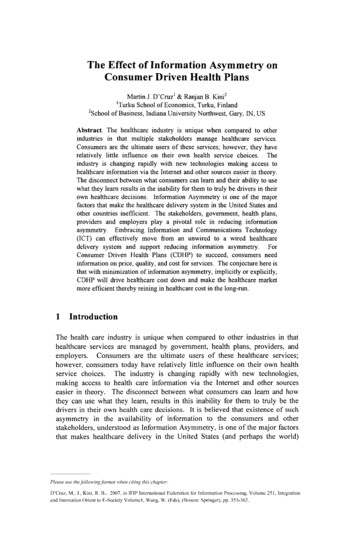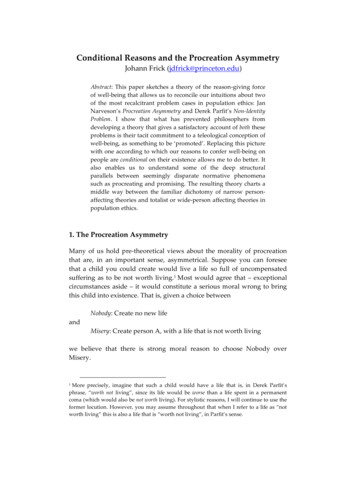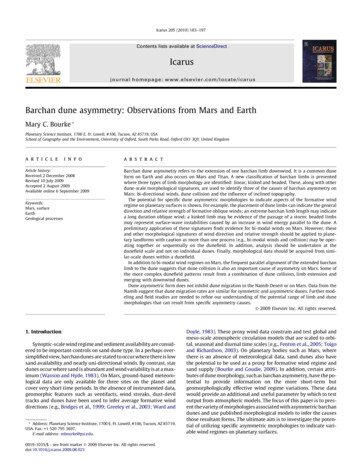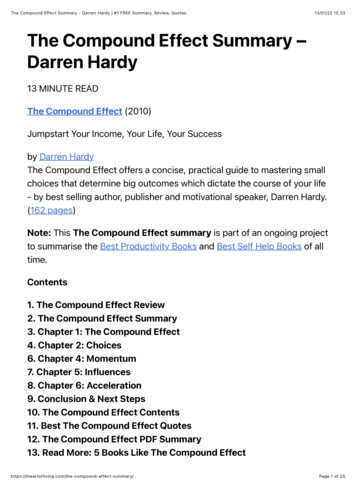
Transcription
The Effect of Information Asymmetry onConsumer Driven Health PlansMartin J. D'Cruz & Ranjan B. Kini Turku School of Economics, Turku, FinlandSchool of Business, Indiana University Northwest, Gary, IN, USAbstract. The healthcare industry is unique when compared to otherindustries in that multiple stakeholders manage healthcare services.Consumers are the ultimate users of these services; however, they haverelatively little influence on their own health service choices. Theindustry is changing rapidly with new technologies making access tohealthcare information via the Internet and other sources easier in theory.The disconnect between what consumers can learn and their ability to usewhat they learn results in the inability for them to truly be drivers in theirown healthcare decisions. Information Asymmetry is one of the majorfactors that make the healthcare delivery system in the United States andother countries inefficient. The stakeholders, government, health plans,providers and employers play a pivotal role in reducing informationasymmetry. Embracing Information and Communications Technology(ICT) can effectively move from an unwired to a wired healthcaredelivery system and support reducing information asymmetry. ForConsumer Driven Health Plans (CDHP) to succeed, consumers needinformation on price, quality, and cost for services. The conjecture here isthat with minimization of information asymmetry, implicitly or explicitly,CDHP will drive healthcare cost down and make the healthcare marketmore efficient thereby reining in healthcare cost in the long-run.1IntroductionThe health care industry is unique when compared to other industries in thathealthcare services are managed by government, health plans, providers, andemployers. Consumers are the ultimate users of these healthcare services;however, consumers today have relatively little influence on their own healthservice choices. The industry is changing rapidly with new technologies,making access to health care information via the Internet and other sourceseasier in theory. The disconnect between what consumers can learn and howthey can use what they learn, results in this inability for them to truly be thedrivers in their own health care decisions. It is believed that existence of suchasymmetry in the availability of information to the consumers and otherstakeholders, understood as Information Asymmetry, is one of the major factorsthat makes healthcare delivery in the United States (and perhaps the world)Please use the following format when citing this chapter:D'Cruz, M., J., Kini, R. B., 2007, in IFIP International Federation for Information Processing, Volume 251, Integrationand Innovation Orient to E-Society Volumel, Wang, W. (Eds), (Boston: Springer), pp. 353-362.
354The Effect of Information Asymmetry on Consumer Driven Health Plansinefficient. It is also generally believed that leveraging Information andCommunication Technology (ICT) can effectively address this factor from anunwired to wired healthcare delivery system [1].In this paper, a discussion of the effects of information asymmetry on CDHPproducts is presented. The stakeholders of this eco-system are the Government,Employers, Health Plans, Providers (hospitals and physicians), and Consumers.The discussion will identify and present the role of information asymmetry as acontributing factor to healthcare industry inefficiencies. Further, the discussionwill also include the trend in the shift of health care cost to consumers with thegrowth of Consumer Driven Health Plans in Managed Care. The critical role ofInformation and Communication Technology in minimizing informationasymmetry in health care industry and its influence in gaining efficiencies inhealth care is also presented.2ResearchThe effect of Information Asymmetry is considered one of the major factors instifling the growth of CDHPs. Information asymmetry is defined as unequalinformation and the consequent role of physicians as agents for patients. It is asituation in which a few have relevant information, and the rest have little.Information asymmetry causes markets to become inefficient since not all theparticipants have access to the information they need for their decision-makingprocesses. Information asymmetry is defined as a gap in knowledge betweenconsumers and professionals regarding price and quality.This gap ofinterpreting performance metrics of physicians, providers and health plans canbe difficult when one party to a transaction has more or better information thanthe other party [2].The stakeholders, the Government, Employers, Providers, Health Plans andConsumers recognize that healthcare cost is out of control and cannot besustainable in the long run. Healthcare professionals and policy makers discusshealthcare information and strategies, but few suggest ideas to fix the problem.Managed Care is now considered a fad that has Plans (CDHP) costs shift to theconsumer. There are already concerns regarding consumer's satisfaction withthese plans, and the future is less than perfectly clear.Consumer Driven Health PlansTo understand how Consumer Driven Health Plan (CDHP) concept was born,it helps to understand how the U.S. healthcare system has evolved over the past50 years. For, in that evolution are lessons the society has learned with respectto healthcare consumption, management and costs.Employer-sponsoredbenefits were born in the 1950s as a way for employers to attract and retainemployees, and that premise holds through today. However, as Americanbusinesses continue to reel in the slumping economy of the new Millennium,how to manage what appears to be an endless cycle of dramatic healthcare costincreases, and, questioning the continuation of funding healthcare benefitsmoreover, is a business issue that employers large and small are taking on with anew vigor.There has been a consensus among the stakeholders that something needs todone to reign the costs of healthcare. This involved getting consumers moreengaged in the healthcare decision making process. There was consensus thathealthcare costs were rising dramatically, and unlike the at-hand solutions that
Martin J. D'Cruzl & Ranjan B. Kini2355managed care provided in the 1980s and 1990s, there was only one viablesolution to manage the new cost trends: Engage the consumer in the purchasing,pricing and utilization of their healthcare services. Defined narrowly, CDHPrefers to health insurance plans that allow members to use personal HealthSavings Accounts (HSAs), Health Reimbursement Arrangements (HRAs), orsimilar medical payment products to pay medical expenses directly, while theyenjoy the protection of a high-deductible health insurance policy. Highdeductible policies cost less per month than low-deductible policies, but theconsumer needs to pay more upfront for medical procedures. This system ofhealthcare is also often referred to as "consumer directed health care" becauseproponents believe it gives consumers greater control over their health andhealth care costs.Cardon and Showalter article identifies five main types of tax-preferredhealth savings accounts shown below [3]:1. Archer Medical Savings Accounts (MSAs): accounts in which an individualand/or an employer can contribute pre-tax dollars to pay for most health careservices. The tax advantage is the same as for employer-provided healthinsurance premiums. Unused monies can accumulate over time. An experimentauthorized under the Kassebaum-Kennedy bill (Health Insurance Portability andAccountability Act of 1996) allowed for restricted introduction of MSAs whichincluded the requirement of purchasing a catastrophic, (high-deductible) healthinsurance policy.2. Flexible Spending Accounts (FSAs): like HSAs, but with no link toinsurance coverage. Funds not used by the end of the year revert to the employer.3. Rollover FSAs: these would allow limited rollover of FSA monies withoutthe restrictions on insurance choices that the current HSA rules require.4. Health Reimbursement Arrangements (HRAs): tax-exempt individualaccounts used to pay for medical expenditures. Employers fund accounts;employee contributions are not allowed. Ownership of the accounts remains withthe employer, unlike HSAs and FSAs.5. Medical IRAs. This proposal would allow consumers to make penalty-freeearly withdrawals from their retirement plans to pay for allowable medicalexpenditures.Proponents argue that most consumers will pay less for healthcare in the longrun under CDHP because not only their monthly premiums will be lower, butalso the use of HSAs and similar products will bring back free-market variablesinto the healthcare system that will encourage competition, lower prices,improved services and lower medical errors.In its infancy stages, CDHP is manifesting itself largely in higher deductibles,higher co-payments, and reduced benefits. There is also a growing array ofCDHP products being offered by all the national health insurance carriers. BlueCross Plans, Cigna, Aetna, United HealthCare and Well Point. In addifion, thereis an expanding industry of niche start-up companies - early entrants such asLemenos and Definity. These two have recently been acquired by Well Pointand United Health Care respectively. In the earlier stages, CDHP was mainlyfocused on cost management and cost shifting. In the longer term, the goal ofCDHP is to engage the consumer in a more educated process of benefitspurchasing, provider selection, and management of consumption of services.One can hypothesize that such an engagement can be at least partially achievedusing Information and Communications Technology (ICT).The growing trend in the increased offering of CDHP products has significantimplications to healthcare providers. With the growth of these plans, the burden
356The Effect of Information Asymmetry on Consumer Driven Health Plansof healthcare falls more on the consumer to pay for higher out-of-pocket-costs.Typically, every time a consumer spends a dollar on physicians' services, only20 cents are paid out of pocket; the remainder is paid by health plan, employerand government referred to as the third party. From a purely economicperspective, then, user's incentive is to consume these services until their valueto them is only 20 cents on the dollar. Additionally, millions of consumers suchas Medicaid enrollees. Medicare enrollees who have medi-gap insurance, andpeople who get free care from community health centers and hospital emergencyrooms, do not even pay the 20 cents. While employers are grappling with theincreasing health care costs, there continues to be a shift to consumers to bearthe responsibility. The shift is expected to accelerate because of the governmentencouragement to enroll as many as 25 percent in high deductible health plansby the end of the decade [4].Early evidence of these CDHP products assisting consumers to reduce costsin most studies is questionable. The results thus far do suggest that CDHP couldreduce the cost and spending on healthcare. The other side of CDHP raisesconcerns about whether reductions in cost are sustainable in the long run.Another concern is whether consumers have the information and resources tobegin making rational decisions about their healthcare situation. Critics havealso raised the issues of whether the consumers will compromise on theappropriate utilization of services or neglect to use the available informationabout quality [5].The growth of these products makes the consumers bear a substantial portionof healthcare cost. The RAND Health Insurance Experiment [HIE] indicatesthat cost sharing (paying out of pocket expenditures by consumer) reduces costsby lowering healthcare utilization, but could also lead to some undesirableconsequences. Cost sharing reduced the percentage of low-income adults whowere associated with higher blood pressure control "highly effective care foracute conditions" by 39 percent. There were reports of less reliable use ofpreventive care measures such as Pep smears. However, advocates believe thatshifting part of the increased cost to the consumer will turn consumers intoinformed consumers who will exert pressure on healthcare providers to improvethe efficiency, quality of care and reduce medical errors [6].Most economists believe that increasing the price of an item will decreasedemand for the item. Health care is no different from any other good. If youincrease the co-payment or coinsurance rate, people will consume fewer medicalservices. The RAND HIE demonstrated that higher coinsurance rates discouragemedical care consumption. [6]In general, most studies, starting with the RAND HIE study, conclude thatincreasing the costs (co-payments and deductibles) of health care to the patientreduces the consumption of health care, but reduces the consumption of bothappropriate and inappropriate care, and the reduction is greater for low-incomepatients. For example, Newhouse, in summarizing the RAND study, reportedthat visits to physicians and hospitals decline with higher cost sharing "althoughfor low income families such cutbacks reduced their use of beneficial as well asunnecessary services and was estimated to have increased rates of death frompreventable illness" [6].Health savings accounts (HSAs) have been a major point of contention forhealth care reformers. Supporters claim that HSAs can reduce health care costsby decreasing the moral hazard problem inherent when third parties—such asinsurance companies or the government—pay for medical services. Opponents
Martin J. D'Cruzl & Ranjan B. Kini2357claim that HSAs will attract rich and healthy individuals, leaving only poor orsick individuals in the 'regular' insurance pool [7].There has been an increase in research analyzing the actual cost and qualityimpact of CDHP, this new form of health care has been increasing. Researchersat the Carlson School of Management at the University of Minnesota (Stephen T.Parente), Harvard University (Meredith Rosenthal), University of Illinois atChicago (Anthony LoSasso) and RAND HIE have examined results of theseplans. The large health plans, Aetna, WellPoint, Humana and UnitedHealthGroup have all provided their own independent analyses as well. Othercountries with experience in this type of health plans include: China, Taiwan,Singapore and South Africa. "Research conducted by the Galen Institute hasfound that consumers around the world who operate under CDHP products arevalue conscious when it came to healthcare and more focused on preventivecare" [6].Critics of CDHP argue that the healthcare system will only burdenconsumers with more expenses because free-market variables can never exist inhealthcare due to lack of pricing transparency, that is clearly established pricing."Despite the theory (as expressed in the Economic Report of the President) thathealth insurance with higher deductibles will lead to consumers shopping aroundfor health services (based on price and quality), the reality of inadequateinformation in the marketplace about health care quality and prices precludes theworkability of a 'consumer-choice' type of model" according to Gail Shearer,director of health policy analysis for Consumers Union, to the Joint EconomicCommittee of the U.S. Congress in February of 2004 [8].Do consumers get adequate healthcare quality and pricing information in themarketplace? The current environment makes it difficult for consumers to bewell informed. Consumers are inundated with enormous amount of medicalinformation from the Internet, medical journals, television and newspaperadvertisements, websites, friends and relatives, to the extent that there isinformation overload. Consumers are becoming more knowledgeable and seekclinical relevant information while demanding prompt responses from themedical profession [9]. In such a situation, can consumers be capable ofassuming the responsibility of making rational health care decisions? On theother hand, will the health of these consumers suffer because they elect not toseek care or adhere to medication regimens? For a long time, consumers wereonly responsible for a minimum payment and the Government, Employer orHealth Plan paid the rest. Now, the informed consumer is expected to takecharge and bring about healthcare efficiencies.3Information Asymmetry in Health CareKenneth Arrow in his seminal article recognized that Healthcare is characterizedby extremely high level of uncertainty and the consumers' uncertainty about theconsequences of purchasing healthcare services. Patients as consumers have thisinherent inability to fiilly understand the effectiveness of medical treatments, andare about the remedy for their sickness or relief of pain. This makes it verydifficult for consumers to learn and evaluate the quality of healthcare services.Arrow also recognized that under conditions of uncertainty, correct informationbecomes a valuable commodity. He further recognized that informafion's
358The Effect of Information Asymmetry on Consumer Driven Health Plans"elusive character" limits the marketability of both the demand and supply sidesof the market. There are limits on consumers' ability to acquire information andconsumers' potential to process information.This is more pronouncedspecifically for cases of acute illnesses where the limits on acquiring informationare uncertain due to inexperience. Furthermore, consumers who are confrontedwith new illnesses face a very challenging dilemma as they have limited time toresearch and collect information. The effectiveness of many medical treatmentsdepends on minimizing the time between the onset of illness and the start of thetreatment [10].Arrow saw the unique asymmetric nature of the information in medicalmarkets. Arrow discusses that some market participants will be better informedthan others will. "Like other commodities, it has a cost of production and a costof transmission, and so it is naturally not spread out over the entire populationbut concentrated among those who can profit most from it", asserts Arrow [11].The average consumer will experience variation in costs and benefits due todifferences in income, analytical abilities and various other factors.Heconcentrated on informational asymmetries between physicians and patients andcomments that "Medical knowledge is so complicated, the informationpossessed by the physician as to the consequences and possibilities of treatmentis necessarily very much greater than that of the patient, or at least so is believedby both parties. Further, both parties are aware of this informational inequality,and their relation is colored in knowledge" [11].With the growth of the Internet, various new sources provide the potentialfor a metamorphosis of physician-dependent patients into better informedconsumers. The Internet will never replace physicians as patients' primarysource of information on the efficacy of various medical treatments. Even forthe most educated consumer with all the relevant medical information, there arebarriers to consumers' abilities to process it and to make choices betweentreatments independently from their respective physicians. Patients tend to relyon guidance from their physicians to understand medical factors in the context oftheir particular medical problems and to give these medical factors their properdiagnosis in the treatment protocols.Accessing medical information from websites, medical journals, providers,health plans relatives, and friends has been the norm for many consumers.Sometimes, consumers can challenge the physician on treatment protocols andforce the physicians to be responsive in a thoughtful way. Websites such aswipricepoint.com (Wisconsin) and nhpricepoint.com (New Hampshire) that havebeen initiated at the state levels can be resource to a certain extent in the charge(price) and some quality indicators. With all the information available, theconsumer is often overwhelmed as to what is the right treatment.Traditional approaches for managing healthcare prices are inadequate in anenvironment of competition. Cognizant of the role the physician plays, thedevelopment of performance based healthcare is still at its embryonic stageaccording to M. Millenson [9]. With the advent of CDHP, the shift of cost to thepatient is inevitable. The consumer will be more judicious with shopping forhealth care services related to cost and quality. Therefore, informationsymmetry becomes highly relevant. In a free market situation where the doctoris primarily motivated by the profit motive, the possibility exists for physiciansto exploit patients by advising more treatment to be purchased than is necessary,a supplier induced demand. Traditionally, physician's behavior is controlled bya professional code of ethics and a system of licensure. In other words, people
Martin J. D'Cruzl & Ranjan B. Kini2359can only work as physicians provided they are licensed and this in turn dependsupon their acceptance of a code which makes the obligations of being an agentexplicit or as Kenneth Arrow puts it that "the control that is exercised ordinarilyby informed buyers is replaced by internalized values" [11].So, if physicians behaved like some financial consultants or computersalesmen in the past and maximized profits without any restriction from aprofessional code, one would expect supplier induced demand to be a majorproblem. But, any system of licensure strong enough to provide the internalizedvalues that Arrow discusses is also likely to give the medical profession powerto limit the number of physicians operating. Thus, licensure and a professionalcode are in themselves also a source of market value. Arrows refers to this as"Supplier induced demand"[11].Although, technology has given us more information than needed, sometimesit is very helpful, if not invaluable. There is good, solid data on the Internet thatresearchers can use with confidence. All of the available information can behelpful to general public with guidance. Searches for quality information havebecome considerably easier and quicker. In this way, information asymmetrycan be reduced. Even if one thinks that one is unfamiliar with this phenomenonone usually goes through experiences in one's life when one was the victim ofinformation asymmetry.Here are a few examples that illustrates information asymmetry:1. When a person is purchasing a new car, does the person feel comfortable andempowered when one starts to negotiate and haggle over price? Or, does theperson feel out of control, not knowing exactly how much should one be payingfor a car?2. When a person is in their physician's office waiting to be called, one may havea list of concerns about which the person may know next to nothing. The personis highly likely a victim of information asymmetry.3. When a person is trying to find information on a stock or a particular industry,the person may go to one's investment adviser who, for some reason may try tochange the person's focus to another stock or industry. The person is not surewhat to do because one is challenged with information asymmetryJessie Gruman, who interviewed 200 patients and families about how theyused scientific information after devastating medical diagnoses, said, "I fear thatthe trend toward consumer-driven health care will disproportionately damage thehealth of the less educated and less wealthy, and that the net effect on thenation's health has already proved negative" [12]. He concluded that mostpatients are unable to make critical decisions about their health care in theconsumer-driven model. According to Gruman some people, called "monitors,"track down detailed information, while other people, called "blunters," do notwant information. In Gruman's study, he commented, one blunter — atheoretical physicist, said that he would be "insulted" if someone read fifteenpapers on theoretical physics and asked him to help design an experiment, hepays his doctor to explain his choices. A "monitor," a lawyer, applied her legalresearch skills but could not think clearly enough to decide. People go toInternet, become overwhelmed (or overloaded), or do not understand thesignificance of the information. "Most health information is bad news, isstressful, and makes decisions even more difficulf [12].According to Robert Reischauer, president of the Urban Institute and ViceChairman of the Medicare Payment Advisory Commission, accessibleinformation on the quality, price, effectiveness and efficiency of health-careservices and providers is developing rapidly, but is nowhere near the minimum
360The Effect of Information Asymmetry on Consumer Driven Health Plansstandard assumed by well functioning CDHP [13]. For example, when one goesto the physician because of a particular set of symptoms, the physician may ask anumber of questions that lead to a series of recommended tests whose resultsthen determine an appropriate treatment regime. One could select the physicianto visit on the basis of price and quality but there is no guarantee that thepackage of tests and treatments that resulted would be the lowest cost or highestquality. The costs of the really expensive treatments would be largelyunaffected.Despite criticism leveled at the new system in 2004, a survey by the BlueCross and Blue Shield Association found widespread satisfaction among HSAcustomers. "The survey found that HSA products are on par with non consumerdirected health plans (CDHPs) with 85 percent of respondents saying the productmeets or exceeds expectations for controlling healthcare expenditures. Thesurvey also revealed that 47 percent of those consumers with HSAs experiencedan increase in satisfaction over the previous year, while only 27 percent ofconsumers with traditional health plans showed an increase in satisfaction" [7].The proponents of CDHP, like former House Speaker Newt Gingrich, havepointed to the rise of the Internet and online comparative shopping healthservices as one reason they believe the CDHP model is viable. Key to CDHP'ssuccess will be the quality (and quantity) dissemination of information abouthealth products and services [14].In 2006, a few of the technology firms capitalized on what they believe willbe a new market for comparative healthcare shopping with the growth of CDHPplans and with the goal of leveraging the Internet to enhance price transparencyand quality information dissemination in the healthcare market [15].If information asymmetry can be minimized, it will help lower prices and leadto price transparency. The use of ICT becomes critical to operationalize such asystem. ICT is already heralded as an effective way to improve quality bothclinical and administrative areas and save money in healthcare. Unfortunately,evaluating return on investment (ROI) for ICT remains challenging. Until amarket mechanism is developed to allow all stakeholders to equitably share thebenefits of ICT adoption, broad-scale adoption will not come to fruition [1].Each of the stakeholders of healthcare delivery is an independent entity.Physician offices are completely separate from the local emergency room orhospital. The same consumer may have laboratory or imaging tests performed inmultiple venues such as several physicians' offices, more than one hospital, andindependent laboratories or imaging facilities. Currently, none of these systemsare linked with others. ICT can assist in improving price transparency, minimizeinformation asymmetry, reduce the price of healthcare and bring efficiency inthe market information. ICT can have a tremendous impact on improvingaccessibility of integrated data from medical claims and providers. The goal isto let consumers of healthcare analyze comparative prices based on quality andprice information related to diagnoses and treatment with improving quality.ICT can play a more significant role in health care today and in the future. Wecan alter the delivery of healthcare, leveraging ICT to give scalable priceefficiencies and improve the dissemination of information. This can reduceinformation asymmetry to the consumers and justify the true price of servicerendered. ICT could have significant impact on improving quality andaccessibility of health care in the US while controlling the price of healthspending using health information technology [16].Strategically, ICT can help remove healthcare information asymmetrybetween all stakeholders in the healthcare industry and, especially between
Martin J. D'Cruzl & Ranjan B. Kini2361ultimate consumer and the rest. ICT makes it possible to connect and share thecritical information necessary in making efficient operation of healthcare servicechain. ICT will allow aggregation, consolidation, summation and differentiationof prices relating to service procedures and value of components services, anddisplay information to consumers to make effective selection of services,providers and physicians. ICT will also allow this interchange and delivery ofthis information to consumers in easy user-friendly methods using webinfrastructure thus empowering all services users. ICT can also empower thehealth care consumers to keep an ongoing dialog and report card on insurers,providers, and physicians with regard to prices and quality of their services [16].4Comments and ConclusionsIn the above discussion, it is made clear that CDHP is here to stay. It is alsotrue that variety of models are being tried to really put consumers in the driverseat in deciding on the true value of the healthcare services. Implicitly andexplicitly several studies have shown that although it is difficult to clearly provethat CDHP will drive the healthcare costs down and healthcare market moreefficient, in the long run they are expected to rein in the healthcare costs.There are several antecedents that are necessary in making such a health caremarket happen.One: The consumers of healthcare should be well informed about all the choicesthey have before they subscribe to any of health care services.Two: The
Consumer Driven Health Plans (CDHP) to succeed, consumers need information on price, quality, and cost for services. . R. B., 2007, in IFIP International Federation for Information Processing, Volume 251, Integration and Innovation Orient to E-Society Volumel, Wang, W. (Eds), (Boston: Springer), pp. 353-362. 354 The Effect of Information .










